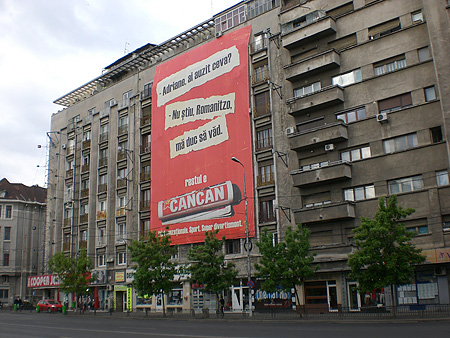Fangled Banners
The Süddeutsche Zeitung ran an alarming story at the weekend about building-sized mega-advertising in Bukarest. We’ve reported on similar situations here in Berlin, where enormous ads cover buildings for the duration of their rennovation, or entire buildings are faked pending their construction. But in Bukarest, gigantic banners have become semi-permanent fixtures of apartment building façades: upwards of six stories in height, they cover windows and balconies.

Mihai, a Bukarest taxi driver interviewed by the SZ, has made peace with the banner covering his apartment. An ad agency pays him 100 Euros in a month, which boosts his income by a third. The obscured view, the darkened interior by day, and the advert’s bright illumination by night appear to be compensated for. But payment only followed months of legal wranglings, and Mihai’s discovery that the ad’s spotlights were illegaly drawing electricity, leech-like, from his own mains line.
One has to imagine a kind of degenerate near-future architecture, entirely subsumed by advertising and free-market dynamics, where access to light, fresh drinking water or a regular energy supply are traded off for cash bonuses or material goods. Or windowless «social» housing projects built for low-income families, subsidised by ads hanging from façades covered in rigging.

That aside, buildings completely covered by ads have long been part of reality in Tokyo. In fact it’s a reason why photos are Tokyo are so alluring in the first place. So what makes the fusion of architecture and advertising so attractive there, and so repellant anywhere else?